

Checkology. Fact-checking U.S. politics. FactCheck.org - A Project of The Annenberg Public Policy Center. FactCheck.org - A Project of The Annenberg Public Policy Center. The definitive Internet reference source for urban legends, folklore, myths, rumors, and misinformation. How “News Literacy” Gets Web Misinformation Wrong – Mike Caulfield – Medium. I have a simple web literacy model.
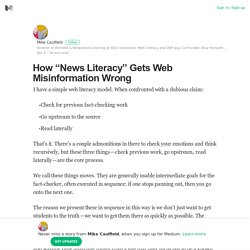
How “News Literacy” Gets Web Misinformation Wrong – Mike Caulfield – Medium. Reading Like A Historian. The Reading Like a Historian curriculum engages students in historical inquiry.
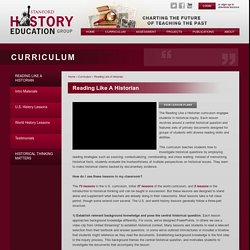
Each lesson revolves around a central historical question and features sets of primary documents designed for groups of students with diverse reading skills and abilities. This curriculum teaches students how to investigate historical questions by employing reading strategies such as sourcing, contextualizing, corroborating, and close reading. Instead of memorizing historical facts, students evaluate the trustworthiness of multiple perspectives on historical issues. They learn to make historical claims backed by documentary evidence. How do I use these lessons in my classroom? The 73 lessons in the U.S. curriculum, initial 37 lessons of the world curriculum, and 5 lessons in the introduction to historical thinking unit can be taught in succession. 1) Establish relevant background knowledge and pose the central historical question. *Note: United Streaming requires a subscription to Discovery Education. Balanced news, issues and opinions, media bias ratings, political news.
How To Spot Fake News. By IFLA Critical thinking is a key skill in media and information literacy, and the mission of libraries is to educate and advocate its importance.
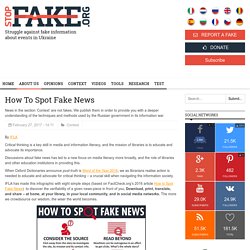
Discussions about fake news has led to a new focus on media literacy more broadly, and the role of libraries and other education institutions in providing this. When Oxford Dictionaries announce post-truth is Word of the Year 2016, we as librarians realise action is needed to educate and advocate for critical thinking – a crucial skill when navigating the information society. IFLA has made this infographic with eight simple steps (based on FactCheck.org’s 2016 article How to Spot Fake News) to discover the verifiability of a given news-piece in front of you.
Download, print, translate, and share – at home, at your library, in your local community, and in social media networks. Download the infographic. Fake News: A Library Resource Round-Up. Librarian Takes It Off In The Stacks; Goes Viral. By Paula Wilson on January 9, 2017.

The News Literacy Project. Fake News Antidote: Teaching Kids To Discern Fact From Fiction : NPR Ed. By now, you've probably heard about one very real consequence of fake news — the infamous "pizzagate" conspiracy theory that ended with Edgar Welch, 28, firing a real gun inside a real Washington, D.C., pizzeria filled with real people.
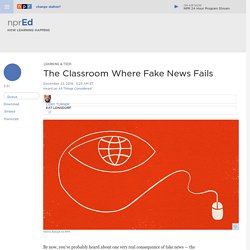
When The New York Times later asked Welch what he thought when he realized there were no child slaves inside the restaurant, as one fake news story had led him to believe, he responded: "The intel on this wasn't 100 percent. " Welch isn't the only one struggling to tell fact from fiction in this digital age. A recent Stanford study found that America's middle, high school and college students are shockingly bad at it, too. It's clear that something has to change in the nation's classrooms. That something, according to Professor Sam Wineburg, one of those Stanford researchers, is "practice. " How To Tell Fake News From Real News In 'Post-Truth' Era.
How to Spot Fake News (and Teach Kids to Be Media-Savvy) Combating Fake News And Teaching Digital Literacy. If the most recent U.S.

Election has taught us anything it's that we live in an era of fake news and sites. With accusations flying of manipulation of stories, the media and voters, it’s truly hard to know if what we read on blogs, social media and other sites is actually the truth or a tale spun to generate clicks. To further compound the problem a recent study from Stanford shows that the vast majority of students can’t determine it what they read on websites is true or baloney.
The study showed More than two out of three middle-schoolers couldn’t see any valid reason to mistrust a post written by a bank executive arguing that young adults need more financial-planning help. And nearly four in 10 high-school students believed, based on the headline, that a photo of deformed daisies on a photo-sharing site provided strong evidence of toxic conditions near the Fukushima Daiichi nuclear plant in Japan, even though no source or location was given for the photo. 10 Ways to Spot a Fake News Article - EasyBib Blog. For many of us, 2016 is going down as a year to forget.

Election upsets, Zika, the Syrian crisis, and unfortunately tons of fake news about all of the above and everything in between. Denzel Washington was recently quoted as saying, “If you don’t read the newspaper, you’re uninformed. If you do read the newspaper, you’re misinformed.” So what should you do? You want to be informed, but a good deal of the information out there is incorrect or biased. 10 Ways to Spot a Fake News Article - EasyBib Blog. Americans — especially but not exclusively Trump voters — believe crazy, wrong things.
Log In. Some analysts worry that foreign intelligence agencies are meddling in American politics and using fake news to influence elections.
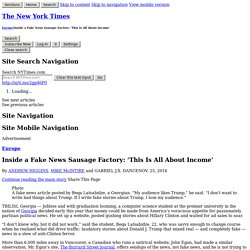
But one window into how the meat in fake sausages gets ground can be found in the buccaneering internet economy, where satire produced in Canada can be taken by a recent college graduate in the former Soviet republic of Georgia and presented as real news to attract clicks from credulous readers in the United States. Mr. Latsabidze said his only incentive was to make money from Google ads by luring people off Facebook pages and onto his websites.
To gin up material, Mr. Latsabidze often simply cut and pasted, sometimes massaging headlines but mostly just copying material from elsewhere, including Mr. Log In. “I just like the satisfaction,” said Mr.

Laughlin, who started his own business and lives in an affluent Twin Cities suburb. “It’s like a hockey game. Everyone’s got their goons. Their goons are pushing our guys around, and it’s great to see our goons push back.” Log In. Photo A fake news article led to gunfire at a Washington pizzeria three weeks ago.
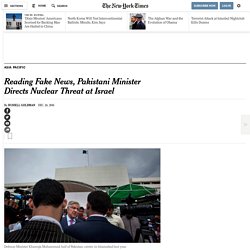
Now it seems that another fake news story has prompted the defense minister of Pakistan to threaten to go nuclear. The defense minister, Khawaja Muhammad Asif, wrote a saber-rattling Twitter post directed at Israel on Friday after a false report — which the minister apparently believed — that Israel had threatened Pakistan with nuclear weapons. Both countries have nuclear arsenals.
“Israeli def min threatens nuclear retaliation presuming pak role in Syria against Daesh,” the minister wrote on his official Twitter account, using an Arabic acronym for the Islamic State. Mr. That story, with the typo-laden headline “Israeli Defense Minister: If Pakistan send ground troops to Syria on any pretext, we will destroy this country with a nuclear attack,” appeared on the website on Dec. 20, alongside articles with headlines like “Clinton is staging a military coup against Trump.” Mr. Continue reading the main story. Log In. Image Eric Tucker, a 35-year-old co-founder of a marketing company in Austin, Tex., had just about 40 Twitter followers. But his recent tweet about paid protesters being bused to demonstrations against President-elect Donald J. Trump fueled a nationwide conspiracy theory — one that Mr. Trump joined in promoting. Mr. But that didn't matter. Fake News Or Real? How To Self-Check The News And Get The Facts : All Tech Considered.
Guido Rosa/Getty Images/Ikon Images Fake news stories can have real-life consequences. On Sunday, police said a man with a rifle who claimed to be "self-investigating" a baseless online conspiracy theory entered a Washington, D.C., pizzeria and fired the weapon inside the restaurant. So, yes, fake news is a big problem. These stories have gotten a lot of attention, with headlines claiming Pope Francis endorsed Donald Trump in November's election and sites like American News sharing misleading stories or taking quotes out of context. And when sites like DC Gazette share stories about people who allegedly investigated the Clinton family being found dead, the stories go viral and some people believe them.